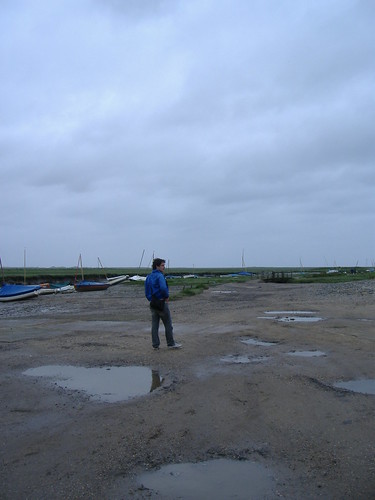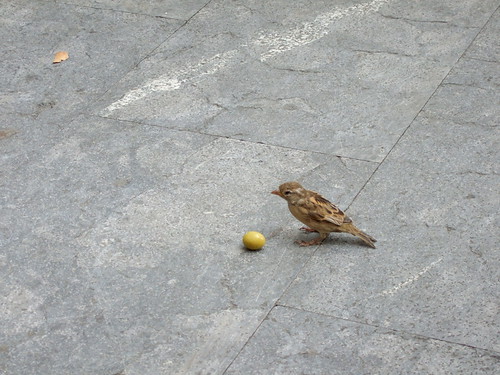
Last weekend, we had been intending to go to the countryside but, on Firday night, I stayed round at Lorc and Mark's house for far too long, doing what you do round there; namely, drinking whatever continential lagers the Co-Op have put on offer, watching movies, and consuming the culinary delights available at nearby gastronomic institute 'Mr Pizza'. So I merrily pottered home at about half-four in the morning, thinking how nice the early morning light was, pleased that I had crossed the 'mugger/ jogger'* date-line and trying to decide if I should bother going to bed at all. When I got home, I did go to bed, and didn't arise until half past eleven, by which time it had started to rain in a particularly attritional manner. Given the paucity of efficient public transport services to most parts of inland rural Norfolk (getting to Blickling Hall, which is about twelve miles away in Aylsham, would have taken the best part of three hours), we rethought and decided to go to the Norwich Castle Museum.
Now, the Castle Museum had become something of a point of shame as regards my campaign for students to 'properly' get to know the city they move to, as I have lived in Norwich for nine years (one whole third of my existence) without having managed to go to it. I've always appreciated the look of the Castle- the outside isn't the medieval facade, but a nineteenth century patch-up, and DUC cause celebre John Soane made external alterations prior to this- and I'd even, on occasion, gone right up to it in order to appreciate the view of the city the motte affords. However, I'd never gone in, assuming- with absolutely no justification whatsoever- that the insides would be boring, cramped and parochial (but not in the fun, Blytonian-surrealist, peculiarly end of the world way that Withernsea Tower of Terror was.) As usual, my knee-jerk impulse proved to be utterly wrong.
The Castle Museum was absolutely spell-binding, an insane combination of a hands-on kids' museum, a fine art gallery, and the inside of a W.G. Sebald novel. Upon arriving, we had a stroll round the marvellous taxidermy exhibits: I now know what a bittern looks like, and why I'll never mess with a Polar Bear should I happen to wind up in the Arctic one day. Up to this point, the museum did have that slightly melancholic 'Sebald and Benjamin' effect, with dimly-lit display cases painted in an archaic shade of Mallard green and buttons that triggered barely-there recordings of roars, tweets and hisses. This, I thought, was a provincial museum at its finest, with a collection that was less representative of its local area than of what the interests of the patricians in that area were: those interests, of course, producing the collections that would eventually be philanthropically donated to the people of the city. If there happens to be a collection of Roman arrowheads discovered within the radius of the city, its presence is virtually always contingent on the benevolence of wealthy amateurs. It's like perusing an architectural manifestation of the psychopathology of Victorianism, with the symptomatic accents falling on hobbyism and civic duty.
From here, however, we found our way into a gallery showing the work of the Norwich School, a group of Dutch-inspired landscape painters whose style was forged in the imagination and technical vision of John Sell Cotman. Many of the paintings had helpful glosses next to them by local writers and artists including, pleasingly, one by UEA's Professor Clive Scott (my secondary supervisor until his retirement, and something of a virtuoso in describing the interdisciplinary transactions between visual and verbal media). I didn't know much about the Norwich School before, but I was hugely impressed by what I saw. For a start, it was fascinating to see the city in which I've lived for almost a decade represented as it was on the immediate cusp of industrialisation: Cotman's paintings seem to depict the degringolade of English agrarianism, and are inhabited by an almost Luddite tension. They also convey a melancholy sense of Norfolk as a county that was in the procedure of losing its national status, of being marginalised as the northern towns grew. Still rather Sebaldian, then.
We passed through a small display of teapots(!) to see more paintings, including some older Flemish landscapes and some later 19th century realism (there was also an absolutely wonderful Hogarth painting of a drunk spewing into a bedpan). A central hall exhibited works chosen by the Norfolk public, which included the efforts of some of Norwich School of Art and Design's alumni from the sixties and seventies. It was good to see the taste of local people reflected in what was on show, particularly as it seems to have proved the point to local arts administrators that non-specialists won't simply select whimsical pieces or works in which prosaic or sentimental realism triumphs over something more complex. The amount of abstract/ modernist art on show in there seemed to suggest something about the success of making experimental art accessible to a wider public via projects like the Tate Modern and the Baltic. I genuinely believe that the 'elitist' perception of modernist art (and, by extension, literature, music, and cinema) has been decently disabused by the decision to allow, and indeed encourage, the wider public to engage with it on their own intellectual terms.
As if this wasn't enough, we discovered- after a sally through the dungeons and keep, which are displayed in typical Terry Deary-style 'making history fun' fashion (no bad thing, perhaps)- we discovered still more art. This, to my surprise, was a small(ish) room inhabited by lesser-known works by the likes of Francis Picabia, Max Ernst, Lucian Freud and even Magritte. In Norwich. And hardly anyone knew they were there. This led to the ecstatic rambling that always happens when my prejudices are disproved, and I declared Norwich to be the 'best-equipped small city in modern art terms in Britain' (we also have the Sainsbury Centre) or some such hyperbole. It probably isn't, but this was a fantastic surprise all the same.
You can't really top chancing across some Max Ernst on a rainy, provincial, June afternoon, so we left- via the slightly uninspiring shop- after that. That, teacher, is 'What I Did Over the Weekend'.
Joe




No comments:
Post a Comment